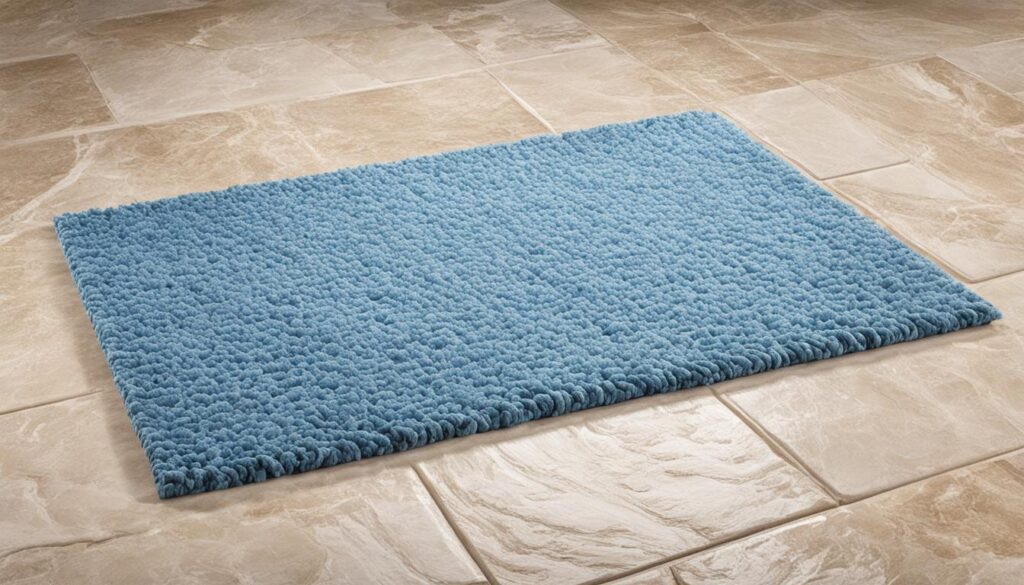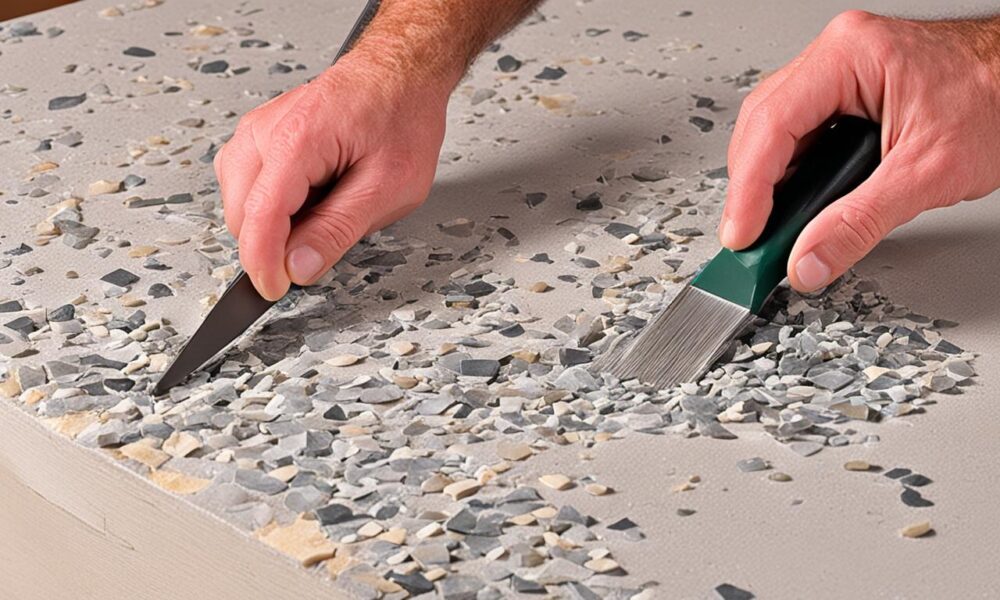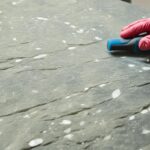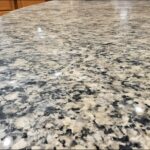DIY Natural Stone Repair: Quick Chip & Crack Solutions
Repairing natural stone surfaces at home can be rewarding. By using the right approach and materials, you can fix chips and cracks yourself. This ensures your stone surfaces last longer. First, you must clean the damaged area well before using epoxy or a specialized filler1. Travertine tiles, for example, have bubbles from compressed marine life exoskeletons. This gives the stone its unique character1. Fixing damages quickly can stop them from getting worse. This saves you from expensive replacements, which are hard due to color changes in tiles from the same quarry1.
Having patience is key since many adhesives take at least 24 hours to dry. Carefully scraping off any extra material and finishing with care makes the repair look perfect. But, if the damage is big or complicated, it’s better to get help from experts like Stone Restoration Works. They help keep your stone surfaces beautiful and strong.
Key Takeaways
- Repairing natural stone is doable for DIYers with the right materials.
- Clean the area well before applying epoxy or a travertine filler1.
- Travertine’s unique bubbles come from marine life exoskeletons1.
- Experts are recommended for big or complex damages.
- Quick fixes can keep your stone valuable and avoid expensive replacements1.
Understanding Different Types of Natural Stone Damage
Natural stone like marble and granite bring beauty and strength to our spaces. Yet, they can get damaged over time. This happens despite their known durability.
Common Causes of Chips and Cracks
Chips and cracks in natural stone can be caused by many things. Dropping heavy objects can chip or crack the tiles2. Things like moving ground or changing temperatures can also cause cracks. This is because the stone moves or gets wet2. Softer stones like limestone are especially at risk for getting scratched2. Fixing these damages might need special tools and materials3.
Distinguishing Between Fissures and Cracks
Knowing the difference between fissures and cracks is key to fixing them right. Fissures are natural and don’t change the tile’s surface much. They look like thin lines3. Cracks, however, are caused by outside forces like shifting ground or temperature changes2. They usually show up in areas that get a lot of use or pressure3. Understanding these helps in figuring out how to best repair the stone, making it last longer.
DIY Natural Stone Repair: Fixing Chips and Cracks
Fixing chips and cracks in natural stone is doable. With proper materials and tools, you can make your stone surfaces look new again. This increases their lifespan and value. Here’s a guide on DIY stone repair.
Materials and Tools Needed
You’ll need these materials and tools for DIY stone repair:
- Putty knife
- Epoxy resin filler
- Diamond blade saw
- Clear resin, like LiquiGlass
- Lamlock Infiltrating Epoxy
- Tenax Tefill Kit
- Pectro color enhancer
These are key for fixing stone damage like chips and cracks. For precision in trimming and repairing stone surfaces, a diamond blade saw is best. This is perfect for common stones in homes like marble and granite4.
Step-by-Step Process for Repairing Chips
To fix stone chips, you’ll need to be careful to make the repair blend well. Here are the steps:
- Clean the Area: Start by cleaning the chipped area well.
- Prepare the Filler: Follow the label instructions to mix the epoxy resin filler.
- Apply the Filler: Fill the chip with the filler using a putty knife.
- Level and Cure: Smooth out the filler and let it cure based on the instructions4.
The Tenax Tefill Kit has everything you need for fixing small holes and chips efficiently5.
Step-by-Step Process for Repairing Cracks
Fixing cracks can be trickier than chips as they may stretch across the tile. Here’s what to do:
- Clean the Crack: Remove loose particles from the crack first.
- Inject Epoxy: Use a low viscosity epoxy for binding the damaged areas well5.
- Fill and Smooth: Fill with color-matched polyester resin and smooth it out for a neat finish.
- Final Cure: Let the repair cure fully as per the epoxy’s instructions4.
Lamlock RocketGel – Instant Epoxy is great for strong and quick repairs, ideal for granite and other stones5.
By using these steps and the right tools, you can fix stone chips and cracks well. This process enhances the beauty and longevity of your stone surfaces.
Preventive Measures to Avoid Future Damage
Adopting preventive measures can lower the chance of future damage to natural stone surfaces. It’s vital to use protective pads and rugs in areas that often get hit.
Using Protective Pads and Rugs
Protective pads and rugs help avoid scratches and chips in busy areas. They serve as a shield to protect the stone. Rugs also make the area look good while keeping the floor safe.
It’s wise to use cutting boards on quartzite countertops to avoid scratches and chips, protecting the stone’s quality over time6. For more tips on safeguarding your quartzite countertops, check out expert advice.

Regular Maintenance Tips
Regular cleaning and resealing extend natural stone’s life. Sealing adds an extra defense against stains and etching6. It’s good to have an annual check-up for the stone’s well-being6.
Quartzite countertops stand out for their strength and looks. Taking good care of them is important6. Despite being less porous, quartzite benefits from timely repairs to keep it in top shape6.
If there are bigger damages, you might need an expert. Keeping up with maintenance and using the stone properly prevent serious problems that could be expensive to fix6.
DIY vs. Professional Repairs: When to Call an Expert
Trying to fix small chips and cracks yourself might not work well. True repair pros like Stone Restoration Works or Slique have the right tools and skills. They get your natural stone looking perfect, even with big damage.
Fixing stone without knowing how can make things worse7. DIY fixes often don’t end well and take lots of time, without sure success7. That’s why it’s better to call a pro in New York for damaged counters and floors7. Experts know the best way to fix different stones and problems.

Safety is important when handling damaged stone7. Pros use the best materials, making repairs last longer and stay strong7. Using experts like Stone Restoration Works or Slique also keeps the stone looking great for years.
Natural stone adds value to a place7. The right fix from a pro keeps it beautiful and valuable. Even though pros may cost more at first, they save money over time. DIY fixes can lead to extra costs if they go wrong7. Learn more about going pro with this guide.
Conclusion
Fixing natural stone involves both art and science. It needs a deep knowledge of the stone and the damage type. Whether you do it yourself or hire pros, the goal is the same. It’s about making stone surfaces look good and last longer. Steps include cleaning, fixing, polishing, and sealing8. Stains from oil, rust, and water can be tough to remove. Acidic stuff can also harm the stone, leaving dull spots9.
To restore stone properly, you need the right tools and products. Things like diamond pads, sealers, pH-neutral cleaners, and polish are key8. Damage from sudden impacts, or hit marks, shows why good planning and quality materials matter to avoid cracks9. It’s important to keep natural stone clean and check for damage regularly9.
If you prefer an expert’s touch, companies like Stone Restoration Studio and Slique are there to help. They can handle everything from stains to cracks. Hiring professionals means you don’t have to worry about the tough work. Whether you do it yourself or get help, caring for natural stone makes your space look and feel better.
FAQ
What are the common causes of chips and cracks in natural stone tiles?
How can I distinguish between fissures and cracks in natural stone?
What materials and tools are needed for a DIY stone repair project?
Can I fix chips in natural stone by myself?
How do I repair cracks in natural stone?
What preventive measures can I take to avoid future damage to my natural stone surfaces?
When should I call a professional for stone repair?
Source Links
- Quick Fixes for Cracked or Chipped Travertine Tiles
- Repairing Chips & Cracks in Natural Stone Tiles: Expert Tips
- REPAIRS | WWW.STONE-REPAIRS.COM
- Repairing Chips & Cracks in Natural Stone Tiles: Expert Tips
- How to Repair Fissures, Cracks and Chips in Countertops
- What To Do If My Quartzite Countertop Chips? – Elegantly Set In Stone
- 5 reasons to hire a stone repair contractor
- Top Tips and Tricks for Restoring Natural Stone Like a Pro – MPG Stone
- Natural Stone Restoration: All You Need To Know | Stone Center



